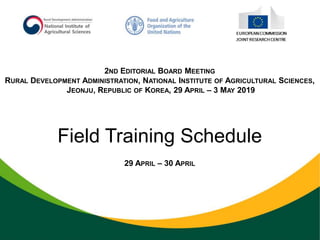Item 1: Field training schedule
- 1. 2ND EDITORIAL BOARD MEETING RURAL DEVELOPMENT ADMINISTRATION, NATIONAL INSTITUTE OF AGRICULTURAL SCIENCES, JEONJU, REPUBLIC OF KOREA, 29 APRIL ŌĆō 3 MAY 2019 Field Training Schedule 29 APRIL ŌĆō 30 APRIL
- 2. National Institute of Agricultural SciencesField Training Schedule Day 1: Monday 29 April 2019 13:40ŌĆō14:00 | Transport: the restaurant to site 1 for first field training 14:00ŌĆō17:00 | Field training (ŌģĀ) 17:00ŌĆō17:20 | Return to hotel 17:20ŌĆō18:10 | Rest 18:10ŌĆō18:30 | Transport: The hotel to restaurant for welcome dinner 18:30ŌĆō | Welcome dinner Day 2: Tuesday 30 April 2019 09:00ŌĆō10:00 | Start: The hotel to site 2 for second field training 10:00ŌĆō12:00 | Field training(ŌģĪ) 12:00ŌĆō12:40 | Lunch (lunch box) 12:40ŌĆō13:40 | Transport: site 2 to visit Saemangeum project office 13:40ŌĆō14:30 | visit Saemangeum project office 14:30ŌĆō15:30 | Transport: Saemangeum project office to site 3 for third field training 15:30ŌĆō18:00 | Field training(Ōģó) 18:00ŌĆō18:30 | Return to the hotel
- 3. Pedon 3 Saemangeum Project Office Pedon 2 Pedon 1 NAS, RDA National Institute of Agricultural Sciences
- 4. Area distribution Soil TaxonomyWRB RSG Area(ha) Ratio(%) Cambisols 4,860,379.1 44.6 Anthrosols 1,748,573.0 16.0 Alisols 1,087,078.0 10.0 Regosols 441,054.5 4.0 Leptosols 416,419.0 3.8 Umbrisols 262,257.9 2.4 Luvisols 248,162.6 2.3 Fluvisols 156,521.5 1.4 Andosols 139,751.5 1.3 Arenosols 26,623.3 0.2 Phaozems 26,289.0 0.2 Histosols 407.9 0.004 Others 1,495,015.6 13.7 Sum 10,908,532.9 Order Area(ha) Ratio(%) Inceptisols 6,118,935.6 56.1 Ultisols 1,251,747.5 11.5 Entisols 1,018,777.1 9.3 Alfisols 820,694.5 7.5 Andisols 135,244.5 1.2 Mollisols 67,710.2 0.6 Histosols 407.9 0.004 Others 1,495,015.6 13.7 Sum 10,908,532.9 National Institute of Agricultural Sciences
- 5. Soils derived from Igneous Rock National Institute of Agricultural Sciences
- 6. Soils derived from Sedimentary Rock National Institute of Agricultural Sciences
- 7. Soils derived from Metamorphic Rock National Institute of Agricultural Sciences
- 8. Soils formed in Holocene National Institute of Agricultural Sciences
- 9. Pedon 1 35 49 22 N, 127 00 55 E Slope: 2Ōł╝7% Soil temperature regime: Mesic Parent material: Diluvium (Bisequum) Landform: Terrace Subsurface horizon : cambic horizon from a depth of 25 to 43cm, argillic horizon from a depth of 43 to 100cm (fragipan from a depth of 68 to 100cm) Pedon 1 National Institute of Agricultural Sciences
- 10. Pedon 2 35 49 48 N, 126 43 05 E Slope: 0Ōł╝2% Soil temperature regime: Mesic Parent material : Fluviomarine deposits Landform: Plains Saline-sodic soils Pedon 2 National Institute of Agricultural Sciences
Editor's Notes
- Good morning. I will briefly describe the two day schedule and The approximate soil distribution of our country.
- On the first day we will see one profile. On the second day we will see two profiles and visit Saemangeum project office.
- This picture is a schematic map that we will move for two days.
- Before you will see the 3 profiles, I will briefly explain the approximate distribution of soils in our country. We classified soils as two classification criteria. WRB is distributed like this table, and Cambisols, Anthrosols and Alisols are about 70% of the total. ST is distributed like this table, Inceptisols, Ultisols and Entisols are about 77% of the total.
- Before you will see the 3 profiles, I will briefly explain the approximate distribution of soils in our country. We classified soils as two classification criteria. WRB is distributed like this table, and Cambisols, Anthrosols and Alisols are about 70% of the total. ST is distributed like this table, Inceptisols, Ultisols and Entisols are about 77% of the total.
- This map shows the distribution of soils derived from sedimentary rocks in Korea. The soils derived from red, gray, and black shales are mainly distributed. Some sandstones and conglomerates are distributed.
- This map shows the distribution of soils derived from metamorphic rocks in Korea.
- This map shows the distribution of soils formed in Holocene. These soils are distributed in flat land.
- Here are the profiles you will see today afternoon. This section is a newly formed soils of 25 cm, and the soils below it is old soil. However, it was not investigated when it was generated. We predict it as the soils produced during the Pleistocene.
- This profile is a newly reclaimed soils. Its parent material is fluviomarine deposits. We will see tomorrow. The third section will be seen tomorrow afternoon.











